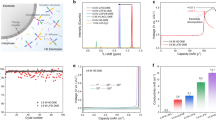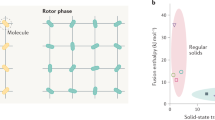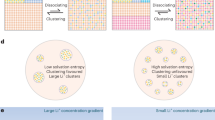Abstract
Zwitterionic materials can exhibit unique characteristics and are highly tunable by variation to the covalently bound cationic and anionic moieties. Despite the breadth of properties and potential uses reported to date, for electrolyte applications they have thus far primarily been used as additives or for making polymer gels. However, zwitterions offer intriguing promise as electrolyte matrix materials that are non-volatile and charged but non-migrating. Here we report a family of zwitterions that exhibit molecular disorder and plasticity, which allows their use as a solid-state conductive matrix. We have characterized the thermal, morphological and structural properties of these materials using techniques including differential scanning calorimetry, scanning electron microscopy, solid-state NMR and X-ray crystallography. We report the physical and transport properties of zwitterions combined with lithium salts and a lithium-functionalized polymer to form solid or high-salt-content liquid electrolytes. We demonstrate that the zwitterion-based electrolytes can allow high target ion transport and support stable lithium metal cell cycling. The ability to use disordered zwitterionic materials as electrolyte matrices for high target ion conduction, coupled with an extensive scope for varying the chemical and physical properties, has important implications for the future design of non-volatile materials that bridge the choice between traditional molecular and ionic solvent systems.
This is a preview of subscription content, access via your institution
Access options
Access Nature and 54 other Nature Portfolio journals
Get Nature+, our best-value online-access subscription
$29.99 / 30 days
cancel any time
Subscribe to this journal
Receive 12 print issues and online access
$259.00 per year
only $21.58 per issue
Buy this article
- Purchase on Springer Link
- Instant access to full article PDF
Prices may be subject to local taxes which are calculated during checkout





Similar content being viewed by others
Data availability
The data represented in the figures in the main paper are available as data files. Source data are provided with this paper. Additional source data are available from the corresponding author upon reasonable request. The crystallographic information file for ZI(1) is available as a Supplementary Information file and has been deposited in the Cambridge Structural Database, Cambridge Crystallographic Data Centre deposition number 2103332.
References
Ichikawa, T. Zwitterions as building blocks for functional liquid crystals and block copolymers. Polym. J. 49, 413–421 (2017).
Das, S. et al. Zwitterionic imidazolium salt: recent advances in organocatalysis. Synthesis 48, 1269–1285 (2016).
Zheng, L. et al. Progress in biodegradable zwitterionic materials. Polym. Degrad. Stab. 139, 1–19 (2017).
Islam, A. et al. Zwitterions for organic/perovskite solar cells, light-emitting devices, and lithium ion batteries: recent progress and perspectives. Adv. Energy Mater. 9, 1803354 (2019).
Woo, H.-S. et al. Ionic liquid-based gel polymer electrolyte containing zwitterion for lithium-oxygen batteries. Electrochim. Acta 345, 136248 (2020).
Soberats, B. et al. Zwitterionic liquid crystals as 1D and 3D lithium ion transport media. J. Mater. Chem. A 3, 11232–11238 (2015).
Yoshizawa, M., Hirao, M., Ito-Akita, K. & Ohno, H. Ion conduction in zwitterionic-type molten salts and their polymers. J. Mater. Chem. 11, 1057–1062 (2001).
Tiyapiboonchaiya, C. et al. The zwitterion effect in high-conductivity polyelectrolyte materials. Nat. Mater. 3, 29–32 (2004).
Yoshizawa, M. & Ohno, H. A new family of zwitterionic liquids arising from a phase transition of ammonium inner salts containing an ether bond. Chem. Lett. 33, 1594–1595 (2004).
Ohno, H. Molten salt type polymer electrolytes. Electrochim. Acta 46, 1407–1411 (2001).
Zhang, H. et al. Single lithium-ion conducting solid polymer electrolytes: advances and perspectives. Chem. Soc. Rev. 46, 797–815 (2017).
Deng, K. et al. Single-ion conducting gel polymer electrolytes: design, preparation and application. J. Mater. Chem. A 8, 1557–1577 (2020).
Li, G. et al. Cations and anions regulation through zwitterionic gel electrolytes for stable lithium metal anodes. Energy Stor. Mater. 24, 574–578 (2020).
Taylor, M. E. & Panzer, M. J. Fully-zwitterionic polymer-supported ionogel electrolytes featuring a hydrophobic ionic liquid. J. Phys. Chem. B 122, 8469–8476 (2018).
Narita, A., Shibayama, W. & Ohno, H. Structural factors to improve physico-chemical properties of zwitterions as ion conductive matrices. J. Mater. Chem. 16, 1475–1482 (2006).
Ohno, H., Yoshizawa-Fujita, M. & Kohno, Y. Design and properties of functional zwitterions derived from ionic liquids. Phys. Chem. Chem. Phys. 20, 10978–10991 (2018).
Yoshizawa-Fujita, M., Tamura, T., Takeoka, Y. & Rikukawa, M. Low-melting zwitterion: effect of oxyethylene units on thermal properties and conductivity. Chem. Commun. 47, 2345–2347 (2011).
Timmermans, J. Plastic crystals: a historical review. J. Phys. Chem. Solids 18, 1–8 (1961).
MacFarlane, D. R., Meakin, P., Amini, N. & Forsyth, M. Structural studies of ambient temperature plastic crystal ion conductors. J. Condens. Matter Phys. 13, 8257–8267 (2001).
Fan, L. Z., Hu, Y. S., Bhattacharyya, A. J. & Maier, J. Succinonitrile as a versatile additive for polymer electrolytes. Adv. Funct. Mater. 17, 2800–2807 (2007).
Shekibi, Y., Ruether, T., Huang, J. & Hollenkamp, A. F. Realisation of an all solid state lithium battery using solid high temperature plastic crystal electrolytes exhibiting liquid like conductivity. Phys. Chem. Chem. Phys. 14, 4597–4604 (2012).
Abu-Lebdeh, Y., Abouimrane, A., Alarco, P.-J. & Armand, M. Ionic liquid and plastic crystalline phases of pyrazolium imide salts as electrolytes for rechargeable lithium-ion batteries. J. Power Sources 154, 255–261 (2006).
Han, H.-B. et al. Ionic liquids and plastic crystals based on tertiary sulfonium and bis(fluorosulfonyl)imide. Electrochim. Acta 55, 1221–1226 (2010).
Forsyth, M. et al. Structure and dynamics in an organic ionic plastic crystal, N-ethyl-N-methyl pyrrolidinium bis(trifluoromethanesulfonyl) amide, mixed with a sodium salt. J. Mater. Chem. A 2, 3993–4003 (2014).
Zhou, Y. et al. Ternary lithium-salt organic ionic plastic crystal polymer composite electrolytes for high voltage, all-solid-state batteries. Energy Storage Mater. 15, 407–414 (2018).
Wade, C. R., Zhao, H. & Gabbaï, F. P. Stabilization of zwitterionic aryltrifluoroborates against hydrolysis. Chem. Commun. 46, 6380–6381 (2010).
Raushel, J. et al. Reinvestigation of aminomethyltrifluoroborates and their application in Suzuki−Miyaura cross-coupling reactions. J. Org. Chem. 76, 2762–2769 (2011).
Efthimiadis, J., Forsyth, M. & MacFarlane, D. R. A surface characterisation and microstructural study by scanning electron microscopy of the N-methyl-N-alkylpyrrolidinium tetrafluoroborate organic salts. J. Mater. Sci. 38, 3293–3301 (2003).
Iranipour, N. et al. Effect of secondary phase on thermal behaviour and solid-state ion conduction in lithium doped N-ethyl-N-methylpyrrolidinium tetrafluoroborate organic ionic plastic crystal. J. Mater. Chem. A 5, 24909–24919 (2017).
Sharma, J. P. & Singh, V. Influence of high and low dielectric constant plasticizers on the ion transport properties of PEO: NH4HF2 polymer electrolytes. High. Perform. Polym. 32, 142–150 (2020).
Dai, Y. et al. Electrical, thermal and NMR investigation of composite solid electrolytes based on PEO, LiI and high surface area inorganic oxides. Electrochim. Acta 43, 1557–1561 (1998).
Jin, L. et al. Structure and transport properties of a plastic crystal ion conductor: diethyl(methyl)(isobutyl)phosphonium hexafluorophosphate. J. Am. Chem. Soc. 134, 9688–9697 (2012).
Seeber, A. J. et al. Conductivity, NMR and crystallographic study of N,N,N,N-tetramethylammonium dicyanamide plastic crystal phases: an archetypal ambient temperature plastic electrolyte material. Phys. Chem. Chem. Phys. 5, 2692–2698 (2003).
Iranipour, N. Organic Ionic Plastic Crystal Nanofibre Composites as Solid State Electrolytes. PhD thesis, Deakin Univ. (2016).
Kitamura, M. et al. Synthesis of pyrrolidinium salts using a triazine-based reagent under mild conditions. Chem. Lett. 43, 1593–1595 (2014).
Palacios, E., Melero, J. J., Burriel, R. & Ferloni, P. Structural, calorimetric, and Monte Carlo investigation of the order–disorder transition of BF4 in (CH3)4NBF4. Phys. Rev. B 54, 9099–9108 (1996).
Lu, S.-Q. et al. High-temperature sequential structural transitions with distinct switchable dielectric behaviors in two organic ionic plastic crystals: [C4H11NBr] [ClO4] and [C4H11NBr] [BF4]. CrystEngComm 20, 454–459 (2018).
Pas, S. J. et al. Defect-assisted conductivity in organic ionic plastic crystals. J. Chem. Phys. 122, 064704 (2005).
Henderson, W. A. et al. An alternative ionic conductivity mechanism for plastic crystalline salt–lithium salt electrolyte mixtures. Adv. Energy Mater. 2, 1343–1350 (2012).
Budi, A. et al. Study of the initial stage of solid electrolyte interphase formation upon chemical reaction of lithium metal and N-methyl-N-propyl-pyrrolidinium-bis(fluorosulfonyl)imide. J. Phys. Chem. C 116, 19789–19797 (2012).
Grande, L. et al. Homogeneous lithium electrodeposition with pyrrolidinium-based ionic liquid electrolytes. ACS Appl. Mater. Interfaces 7, 5950–5958 (2015).
Jin, L. et al. Lithium doped N,N-dimethyl pyrrolidinium tetrafluoroborate organic ionic plastic crystal electrolytes for solid state lithium batteries. J. Mat. Chem. 21, 10171–10178 (2011).
Evans, J., Vincent, C. A. & Bruce, P. G. Electrochemical measurement of transference numbers in polymer electrolytes. Polymer 28, 2324–2328 (1987).
Basile, A., Hollenkamp, A. F., Bhatt, A. I. & O’Mullane, A. P. Extensive charge–discharge cycling of lithium metal electrodes achieved using ionic liquid electrolytes. Electrochem. Commun. 27, 69–72 (2013).
Porcarelli, L. et al. Single–ion conducting polymer nanoparticles as functional fillers for solid electrolytes in lithium metal batteries. Preprint at ChemRxiv https://chemrxiv.org/engage/chemrxiv/article-details/61256a9b9d6e6e78d674049f (2021).
Long, L., Wang, S., Xiao, M. & Meng, Y. Polymer electrolytes for lithium polymer batteries. J. Mater. Chem. A 4, 10038–10069 (2016).
Monroe, C. & Newman, J. The impact of elastic deformation on deposition kinetics at lithium/polymer interfaces. J. Electrochem. Soc. 152, A396 (2005).
Qian, J. et al. High rate and stable cycling of lithium metal anode. Nat. Commun. 6, 6362 (2015).
Forsyth, M. et al. Inorganic-organic ionic liquid electrolytes enabling high energy-density metal electrodes for energy storage. Electrochim. Acta 220, 609–617 (2016).
Perez Beltran, S., Cao, X., Zhang, J.-G. & Balbuena, P. B. Localized high concentration electrolytes for high voltage lithium–metal batteries: correlation between the electrolyte composition and its reductive/oxidative stability. Chem. Mater. 32, 5973–5984 (2020).
CrysAlisPro v.1.171.39.46 (Rigaku Oxford Diffraction, 2018).
Sheldrick, G. Crystal structure refinement with SHELXL. Acta Crystallogr. Sect. C 71, 3–8 (2015).
Guan, X. & Stark, R. E. A general protocol for temperature calibration of MAS NMR probes at arbitrary spinning speeds. Solid State Nucl. Magn. Reson. 38, 74–76 (2010).
Bielecki, A. & Burum, D. P. Temperature dependence of 207Pb MAS spectra of solid lead nitrate. An accurate, sensitive thermometer for variable-temperature MAS. J. Magn. Reson. A 116, 215–220 (1995).
Bruce, P. G. & Vincent, C. A. Steady state current flow in solid binary electrolyte cells. J. Electroanal. Chem. 225, 1–17 (1987).
Acknowledgements
This work was supported by the Australian Research Council (ARC) through Discovery Grant DP170101087, the Centre of Excellence for Electromaterials Science (CE140100012) and the ARC Training Centre for Future Energy Storage Technologies (IC180100049). L.P. received funding from the European Union’s Horizon 2020 research and innovation programme under the Marie Skłodowska–Curie grant agreement no. 797295. D.M. acknowledges funding by the Basque Government through Elkartek KK-2020/00078 and Agencia Estatal de Investigación (PID2020-119026GB-I00).
Author information
Authors and Affiliations
Contributions
F.M. designed and executed the experiments, analysed data and prepared the manuscript. L.A.O. supervised NMR experiments, analysed data and edited the manuscript. L.P. designed and synthesized the NPs and analysed results. C.F. collected X-ray structure data and analysed and interpreted results. N.Q., M.A. and O.H. synthesized zwitterions, including the experimental design, execution and analysis of synthesis results. D.M. conceived and designed the lithium-functionalized polymer NPs. M.F. contributed to project planning, interpretation of results and manuscript editing. J.M.P. contributed to project concept and design, interpretation of results and manuscript preparation.
Corresponding author
Ethics declarations
Competing interests
The authors declare no competing interests.
Additional information
Peer review information Nature Materials thanks Catalin Gainaru and the other, anonymous, reviewer(s) for their contribution to the peer review of this work.
Publisher’s note Springer Nature remains neutral with regard to jurisdictional claims in published maps and institutional affiliations.
Supplementary information
Supplementary Information
Supplementary Figs. 1–19, Tables 1–4 and Discussion.
Supplementary Data
Crystallographic information file for ZI(1).
Source data
Source Data Fig. 2
Statistical source data.
Source Data Fig. 3
Statistical source data.
Source Data Fig. 4
Statistical source data.
Source Data Fig. 5
Statistical source data.
Rights and permissions
About this article
Cite this article
Makhlooghiazad, F., O’Dell, L.A., Porcarelli, L. et al. Zwitterionic materials with disorder and plasticity and their application as non-volatile solid or liquid electrolytes. Nat. Mater. 21, 228–236 (2022). https://doi.org/10.1038/s41563-021-01130-z
Received:
Accepted:
Published:
Issue Date:
DOI: https://doi.org/10.1038/s41563-021-01130-z
This article is cited by
-
Designing phosphazene-derivative electrolyte matrices to enable high-voltage lithium metal batteries for extreme working conditions
Nature Energy (2023)
-
Sequencing polymers to enable solid-state lithium batteries
Nature Materials (2023)
-
Force-induced ion generation in zwitterionic hydrogels for a sensitive silent-speech sensor
Nature Communications (2023)
-
Zwitterion-doped self-supporting single-ion conducting polymer electrolyte membrane for dendrite-free lithium metal secondary batteries
Science China Materials (2023)



